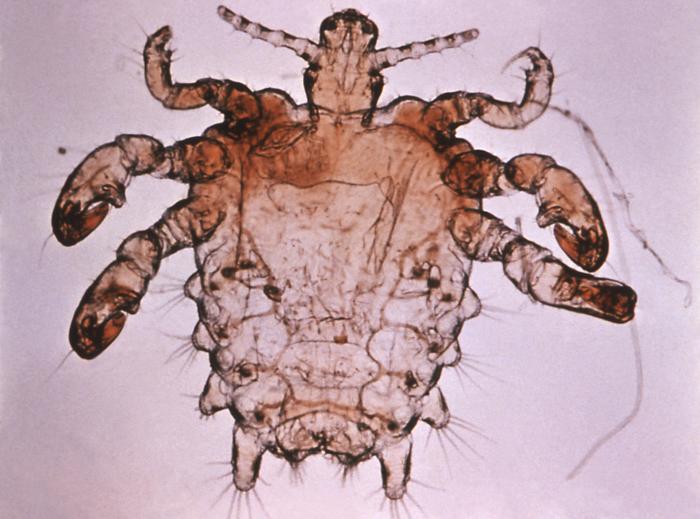Pediculus pubis
| Phthirus | ||
 | ||
|---|---|---|
| A magnified crab louse | ||
| ICD-10 | B85 | |
| ICD-9 | 132 | |
| DiseasesDB | 10028 | |
| MedlinePlus | 000841 | |
| eMedicine | emerg/298 | |
| MeSH | B01.500.131.617.564.159.730 | |
| Pubic louse or "Crabs" | ||||||||||||||||
|---|---|---|---|---|---|---|---|---|---|---|---|---|---|---|---|---|
 | ||||||||||||||||
| Scientific classification | ||||||||||||||||
| ||||||||||||||||
| Binomial name | ||||||||||||||||
| Pthirus pubis (L., 1758, originally Pediculus pubis) |
Editor-In-Chief: C. Michael Gibson, M.S., M.D. [1]
Overview
The pubic or crab louse (Phthirus pubis) is a parasitic insect which spends its entire life on human hair and feeds exclusively on blood. Humans are the only known host of this parasite. Humans can also be infested with body lice (Pediculus humanus humanus) and with head lice (Pediculus humanus capitis)
Morphology
The dorso-ventrally flattened body of the louse is divided into head, thorax and abdomen. A pair of eyes and a pair of antenna are clearly visible on the head. The mouthparts are adapted to piercing the skin and sucking blood. The second and third pair of legs, with their terminal claws are adapted to holding the hair-shaft, while the first pair of leg holds the skin during feeding. Abdominal protuberances on the side of the body are characteristic of this species. Males are slightly smaller than females. The eggs are oval-shaped and ca. 0.8 mm in length. Immediately after oviposition they are shiny, round, and transparent. Pubic lice are 1-2- mm in size, varying according to the stage of their development. They are usually whitish-grayish in color they become reddish-brown for some time after blood-meal.
Biology
Pubic lice are insect parasites, spending their entire life on the host's hair and skin and feeding exclusively on blood, 4-5 times daily. The life-cycle from egg to adult is 22-27 days. The egg hatches producing the first nymphal stage, which after three moltings develops to nymph 2, nymph 3 and subsequently to either a male or female louse. The incubation period of the egg is 7-8 days, while the rest of the cycle is taken up with the development of nymphal stages. The average adult female lives for 17 and the male for 22 days. [1] [2].
Evolutionary theory of origin
The most recent genetic research indicates that crab lice are related to the louse endemic to gorillas, Pthirus gorillae, having spread to early hominids from the ancestors of gorillas several millions of years ago, rather than having diverged from human head lice as was previously generally thought.[3]
References
- ↑ Nuttall GHF. 1918. The biology of Phthirus pubis. Parasitology 10: 383-405.
- ↑ Payot F. 1920. Contribution a l'etude du Phthirus pubis (Linne, Leach). Bull. Soc. vaud. Sci. nat. 53: 127-161.
- ↑ http://www.biomedcentral.com/1741-7007/5/7/abstract
See also
External links
- Pubic Lice Pictures & Information
- University of Florida information on Crab Louse
- Edinburgh Royal Infirmary on Public Lice
- Medline Plus article*Lindane Facts
- Guideline on the Management of Phthirus pubis infestation (UK, 2007)
- Genetic Analysis of Lice Supports Direct Contact Between Modern and Archaic Humans